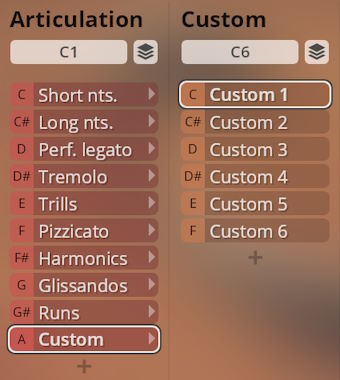Synchron Duality Strings
Introduction
Welcome to the Vienna Symphonic Library’s series of Synchron Instruments! The instruments were recorded at Stage A, the main hall of Vienna’s revitalized Synchron Stage Vienna, and Stage B, our smaller and more intimate studio. The recordings were executed using an expansive, phase-controlled multi-microphone set-up, capturing string effects played in a scoring stage with exceptional acoustics, now ready to be used in your studio. This document will provide you with the information you need to use the Library with our Vienna Synchron Player.
There are two Duality Strings collections: one features regular articulations, the other is played con sordino. Apart from that, the only difference is that the con sordino articulations do not include snap pizzicato.
Concept
You would rightly assume that the library’s name has something to do with how it works. Indeed, it offers two ensembles of every string group, a larger orchestral one and a smaller chamber one, playing and recorded simultaneously, but in different ambiences. The larger ensembles played at our renowned Synchron Stage A with its lush cinematic reverb, the same as you may be familiar with from our other Synchron collections. The smaller ensembles, however, were set up at Stage B, which provides a much drier and crisper reverb environment.
This unique recording technique allows you to use the dual ensembles to fine-tune the sound of your compositions without having to layer different libraries, where the authenticity you can achieve is often less than you’d wish for.
Stage B also features two different microphone setups, so that you have “Bright” and “Dark” versions of the dry stage recordings at your command.
Of course, you can use the large and small ensembles in combination or separately!
Section Sizes
| Stage A | Stage B | total |
|---|---|---|
| 14 1st Violins | 8 1st Violins | 22 |
| 12 2nd Violins | 6 2nd Violins | 18 |
| 10 Violas | 5 Violas | 15 |
| 10 Cellos | 5 Cellos | 15 |
| 6 Basses | 3 Basses | 9 |
Standard and Extended Library
The microphone setup was subdivided into 10 recording positions. The Standard Library includes 5 of these positions (as well as a RAM-friendly Room Mix composed of merged samples from the individual positions), allowing you to integrate instruments recorded with a stereo Decca tree into your projects with our Synchron Player software that was designed exactly for that purpose. Adding the Extended Library and thus getting the Full Library expands your possibilities to 5.1 surround and Auro 3D 9.1, with the additional option of a microphone in the rear of the hall to expand your sound possibilities.
Microphone positions
Standard Library
-
- A - Room Mix – Stereo
-
- A - Solo – Mono
-
- A - Mid– Stereo (L/R)
-
- A - Main/Room Mic – Decca Tree Stereo (L/R)
-
- A – Main C/Room Mic – Decca Tree Mono (Center)
-
- B - “Dark” microphones – Stereo (L/R)
-
Extended Library
-
- A - Ribbon – Stereo (L/R)
-
- A - Main Surround – Stereo (L/R)
-
- A - High Stereo (3D) – Stereo (L/R)
-
- A - High Surround (3D) – Stereo (L/R)
-
- B - “Bright” microphones – Stereo (L/R)
-
Mixer Presets
For each ensemble, there are a number of Mixer Presets that depict different recording situations. The basic Mixer Presets are Close, Classic, Wide, Distant, Ambience, Lush, and Lush Long. These are available in stereo versions for Room-Mix, Standard and Full, as well as in Surround. Moreover, there is a Special category, also for Standard and Full.
By default the classic room mixes are loaded which include the Standard Library microphone positions “Room-Mix” and “Mid” from Stage A, and “Dark” from Stage B. These are balanced in the stereo field to represent the respective instrument’s position in the Synchron Stage set-up.
Immersive Sound and Auro 3D
Auro 3D is an immersive audio technology that allows for three-dimensional sound perception. The Belgian company Auro Technologies developed this technology based on a special speaker configuration, adding four additional speakers to a 5.1 surround configuration. These speakers (so-called “Heights”) are situated above the front and surround speakers and generate acoustic reflections that are perceived naturally due to the fact that sounds originate from around as well as from above the listener. Thanks to the comprehensive selection of discrete audio channels with the Full Library, you may mix your instruments in Auro 3D as well as in Dolby Atmos.
Articulation categories
The Presets of each instrument group are subdivided into different Articulation categories (including one named “Custom”, ready for your own creations):
- Short Notes
- Long Notes
- Performance legato
- Tremolo
- Trills
- Pizzicato
- Harmonics
- Glissandos
- Runs
Within these Articulation categories, you can select a Type, e.g., spiccato or staccato, and for some of the types there are additional options available, such as the short notes’ bold or agile playing.
Pitch
For designating pitch, the Vienna Symphonic Library uses International Pitch Notation (IPN), which was agreed upon internationally under the auspices of the Acoustical Society of America. In this system the international standard of A=440 Hz is called A4 and middle C is C4. All pitches are written as capital letters, their respective octave being indicated by a number next to it. The lowest C on the piano is C1 (the A below that is A0), etc.
The Synchron Player software allows you to set middle C to C3, C4, or C5 according to your preference. Selecting another setting than C4 will of course also change the play ranges and keyswitches accordingly.
Synchron Duality Strings - Presets
The Presets for Synchron Strings Pro comprise all the instruments’ recorded Patches in Articulation groups, which again contain Types of the respective Articulation, with further options if available. If you happen to be short of RAM, you can deactivate Articulations you do not need, and if necessary activate them again.
By default the keyswitches for Articulations are mapped from C1 to A1 (for Middle C = C4) for violins, violas, and cellos, and C5 to A5 for the double basses. The Type keyswitches start from C2/F2 (depending on articulation) for violins and violas, and from C6/F6 for cellos and basses. The keyswitchies for further options such as release and attack variants are mapped to the keyboard's 7th octave.
Dimension Controllers offer additional options within some Articulations or Types, most notably that of crossfading between different attack and release variations. The controller function is indicated by the respective caption, as of course it may take on different tasks as needed.
- Articulations
- violins
- violas
- cellos C1–A1
- basses C5–A5
- Type
- violins and violas from C2/F2
- cellos and basses from C6/F6
- Attack, release, other variants: starting at C7
- XF control: MIDI continuous controllers (CC)
Please note that the content of Synchron Duality Strings (regular) was upgraded in April 2024, adding hard staccatos and long notes without vibrato. Text and screenshots follow the expanded content.
Preset types
The collection offers four basic Preset types for every section in separate folders named “VelXF sus - MOD”, “VelXF - MOD”, “VelXF + Velocity control”, and “Velocity”. In VelXF sus Presets, velocity crossfading by modwheel is only activated for long notes, while the dynamics of short notes are controlled by keystroke velocity, thus facilitating phrasing. In VelXF Presets, all articulations have velocity crossfading activated so that you can control dynamics with MIDI controller CC1, the modwheel. VelXF + Velocity control also use the modwheel, but in addition keystroke velocity is used to determine the attack behaviour of long notes, legato, etc. Moreover, there are special patch combinations, e.g., where velocity triggers spiccato or staccato samples.
Velocity crossfading can be enabled or disabled by clicking its on/off symbol in the Synchron Player's Perform tab, or you can use the Velocity Preset where the dynamics are generally controlled by keystroke velocity.
Apart from the individual string ensembles, there are also Presets containing all ensembles as shown in the screenshot below. These 'Tutti' are available in full range and compressed range versions. You will find them especially useful for quick layouts and for live play. The tutti Presets feature two types of stacking:
Tutti full range
- Mapping range: B0–D7
- Basses B0–B2
- Cellos C2–B3
- Violas C3–F#4
- 2nd violins C4–D7
- 1st violins G4–D7
- Articulation keyswitches: C~–G#~
- Type keyswitches: starting at C0/F0 depending on articulation
Tutti compressed range
- Mapping range: C2–D6
- Basses C2–B2
- Cellos C2–B3
- Violas C3–B3
- 1st and 2nd violins C4–B5
- Articulation keyswitches: C1–G#1
- Type keyswitches: starting at C6/F6 depending on articulation.
Please note that in the compressed range Presets, the basses sound one octave lower than played, the 1st violins one octave higher.
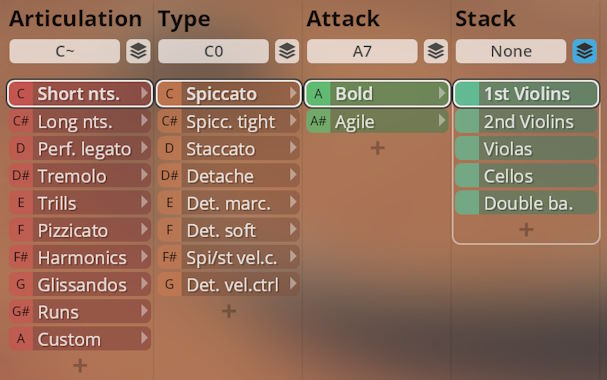
Regular + sordino merged
If you have both the regular and sordino collections of Duality Strings installed, your Preset browser will list another category of Presets including both of them. They have the same structure as the single collection Presets, but add another Dimension for switching between regular and con sordino articulations.
- Regular / con sordino: A0 / B0.
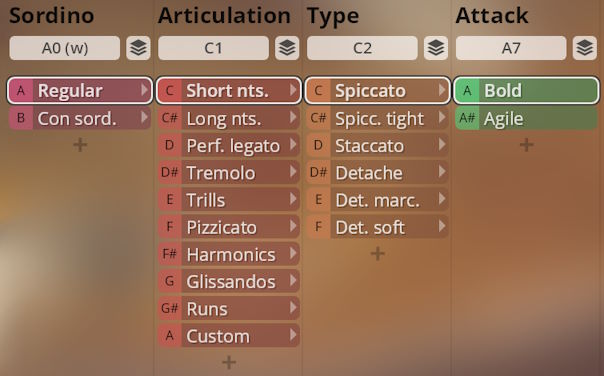
Short notes
Spiccato normal and tight, staccato normal and hard, and détaché normal / marcato / soft. All with "bold" and "agile" attack variants.
- Type
- C2–F#2 (violins, violas)
- C6–F#6 (cellos, basses)
- Bold / Agile: A7 / A#7
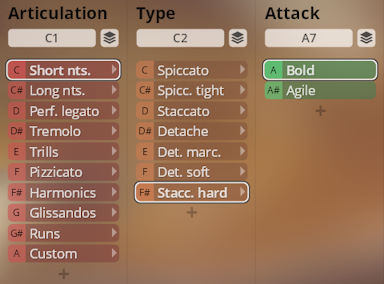
VelXF + Velocity control specials
In the VelXF + Velocity Presets, the short notes have two additional types which employ velocity control to switch between articulations:
- Spiccato/staccato velocity control
- Détaché velocity control
Dim.Ctrl/C (keystroke velocity) is used to trigger different patches (spiccato/staccato/staccato hard resp. soft/normal/marcato détache).
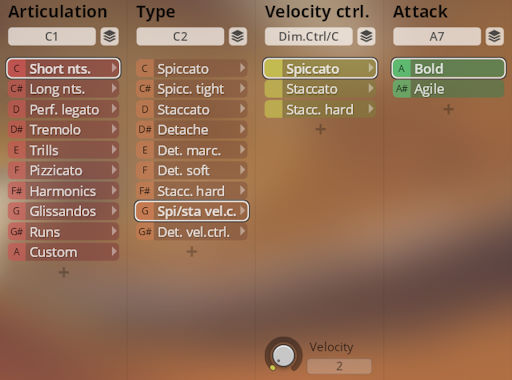
Long notes
Long notes with light, strong, and without vibrato, espressivo, and swelling tones.
Poco / molto vibrato
Long notes with light and strong vibrato, normal/soft/fast/sfz attack, with normal, soft, and very soft release.
- Expression
- F2–A2 (violins, violas)
- F6–A6 (cellos, basses)
- Release: F7–G7
- Attack: A7–C8
In VelXF + Velocity Presets, attack is controlled by keystroke velocity instead of keyswitches.
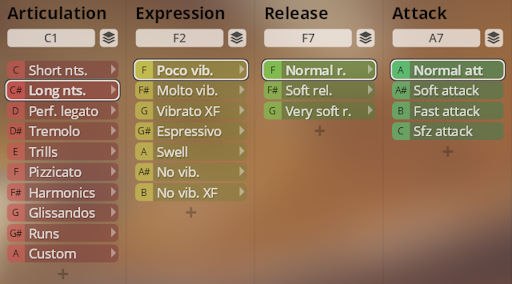
Vibrato XF
Crossfading combination of poco and molto vibrato. Use Dim.Ctrl/A (CC20) to adjust crossfading.
- Vibrato XFade: Dim.Ctrl/A (CC20)
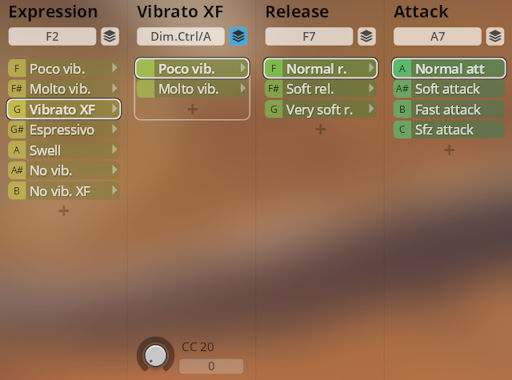
Espressivo, swell
Espressivo and swelling notes with normal, soft, and very soft release.
- Release: F7–G7
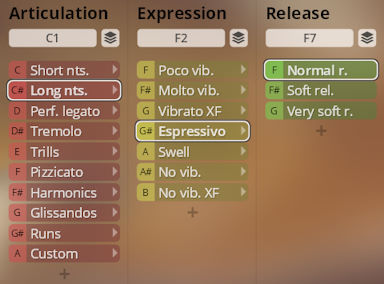
No vibrato
Long notes without vibrato, with normal and fast attack.
- Attack: A7–B7.
- In VelXF + Velocity Presets, attack is controlled by keystroke velocity instead of keyswitches.
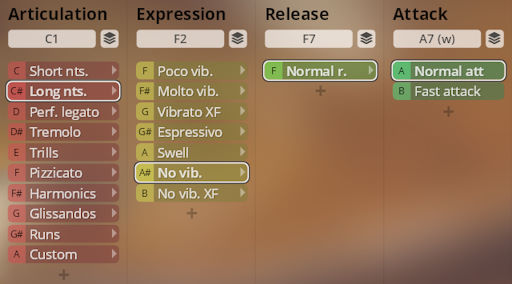
No vib. XF
Crossfading combination of no vibrato and molto vibrato. Use Dim.Ctrl/A (CC20) to adjust crossfading.
- Vibrato XFade: Dim.Ctrl/A (CC20).
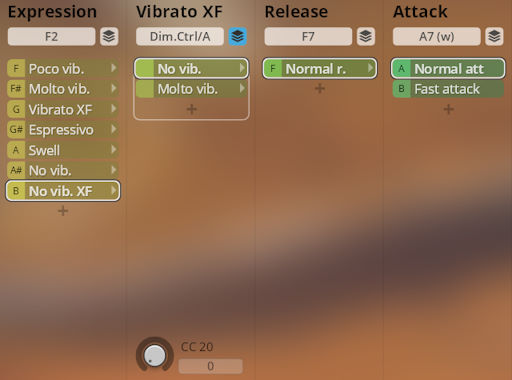
Performance Legato
Legato normal and agile, slurred legato, and portamento with light and strong vibrato, and espressivo (except agile), all with release and attack variants; including an auto-speed option between normal and agile legato.
- Type
- C2–E2 (violins, violas)
- C6–E6 (cellos, basses)
- Release: F7–G7
- Attack: A7–C8.
In VelXF + Velocity Presets, attack is controlled by keystroke velocity instead of keyswitches.
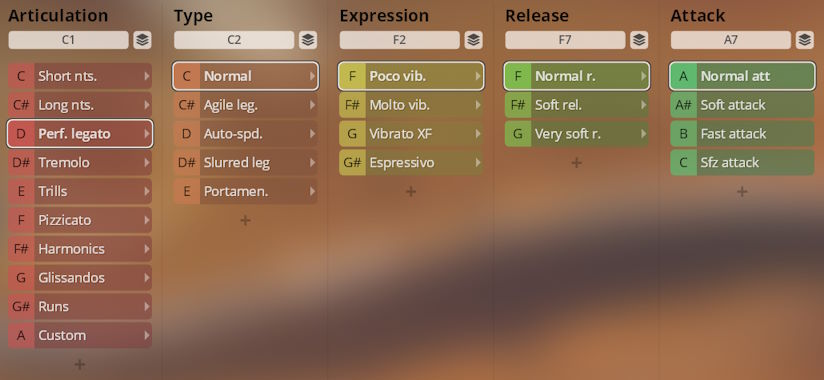
Vibrato XF
Crossfading combination between poco and molto vibrato. Use Dim.Ctrl/A (CC20) to adjust crossfading.
- Vibrato XFade: Dim.Ctrl/A (CC20)
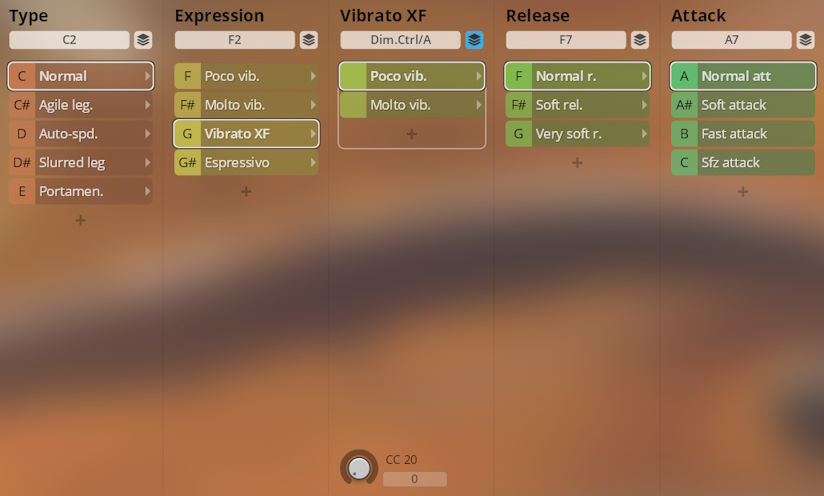
Auto-speed
This option implements a controller on Dim.Ctrl/B to switch automatically between regular and agile legato according to playing speed.
- Speed controller: Dim.Ctrl/B (playing speed).
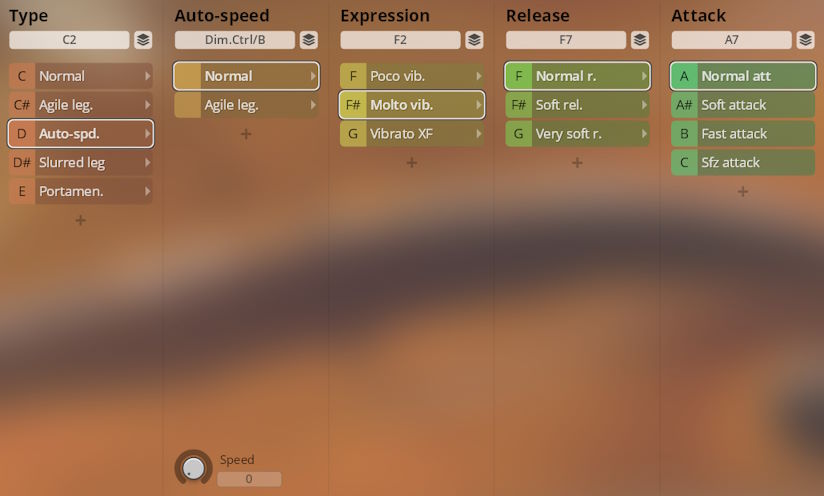
Tremolo
Tremolo with normal, legato, and slurred transitions; fast and slow with attack variants, and measured.
- Type
- C2–E2 (violins, violas)
- C6–E6 (cellos, basses)
- Transition: F7–G7
- Attack: A7/B7/C8
In VelXF + Velocity Presets, attack is controlled by keystroke velocity instead of keyswitches.
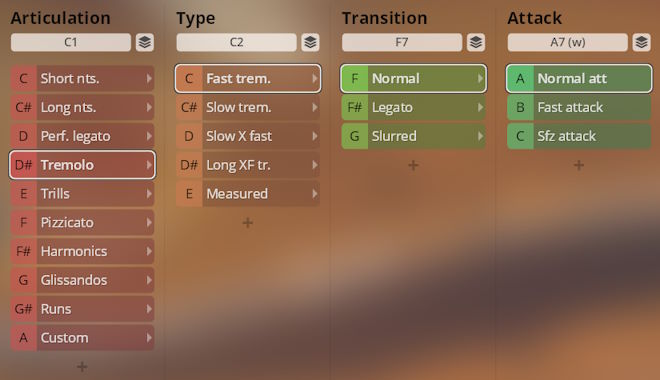
Slow X fast
Use Dim.Ctrl/A (CC20) to crossfade between slow and fast tremolo.
- Slow/fast XFade: Dim.Ctrl/A (CC20)
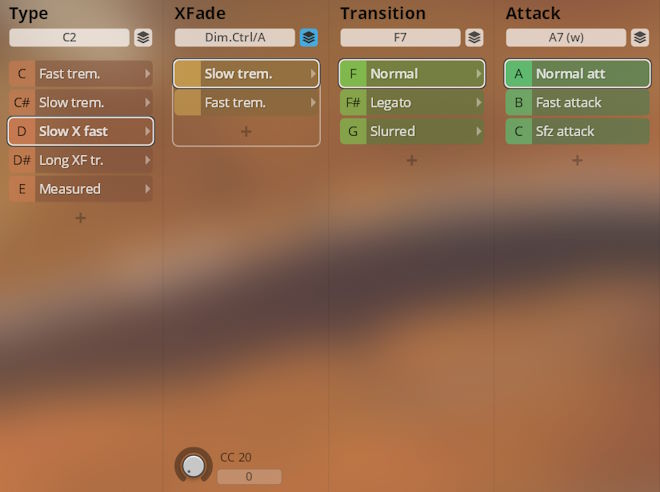
Long X tremolo
Use Dim.Ctrl/A (CC20) to crossfade between sustained notes and tremolo.
- Sustained/tremolo XFade: Dim.Ctrl/A (CC20)
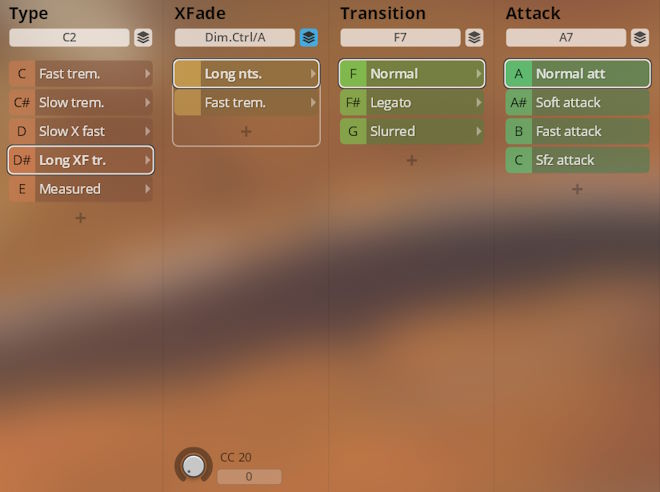
Measured tremolo
Tremolo played at 120/130/140/160/180 BPM; normal, legato, and slurred transitions, as well as cut release.
- Tempo
- F2–A2 (violins, violas)
- F6–A6 (cellos, basses)
- Release: F7–G#7
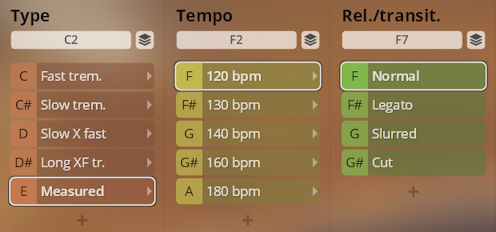
Trills
Trills, minor 2nd to major 3rd, with normal, legato, and slurred transitions.
- Interval
- F2–G#2 (violins, violas)
- F6–G#6 (cellos, basses)
- Transition: F7–G7
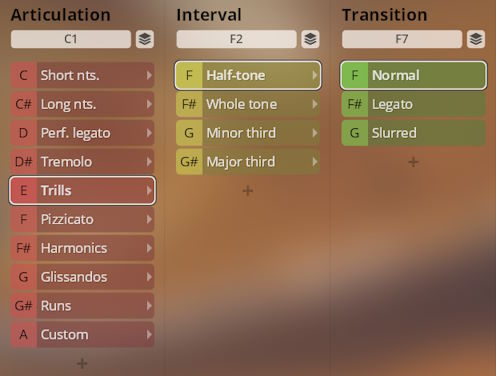
VelXF + Velocity control
In VelXF + Velocity Presets, the trills are organized in a different manner, so that minor/major intervals are controlled by keystroke velocity instead of keyswitches.
- Second/third
- F2/F#2 (violins, violas)
- F6/F#6 (cellos, basses)
- Minor/major
- Dim.Ctrl/C (keystroke velocity)
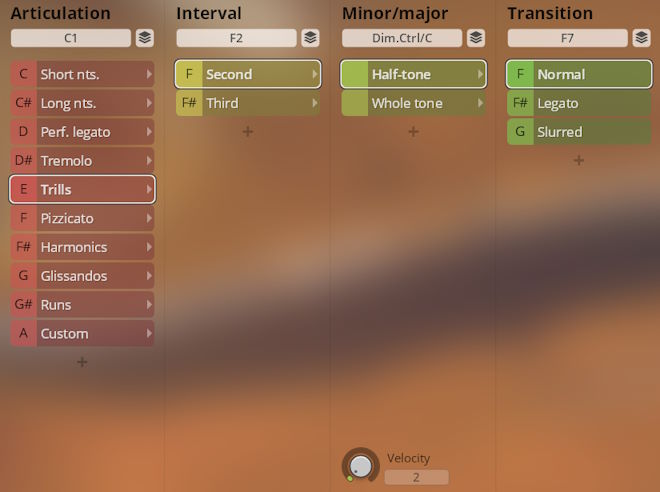
Pizzicato
Pizzicato, bold and agile; snap pizzicato (regular only); col legno, bold and agile.
- Type
- C2–D2 (violins, violas)
- C6–D6 (cellos, basses)
- Bold/agile: A7/A#7
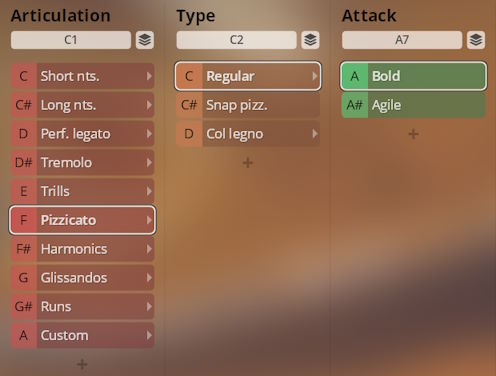
VelXF + Velocity control specials
Regular/snap pizzicato
Dim.Ctrl/C (keystroke velocity) is used to trigger regular pizzicato at lower velocities, and snap pizzicato at higher ones.
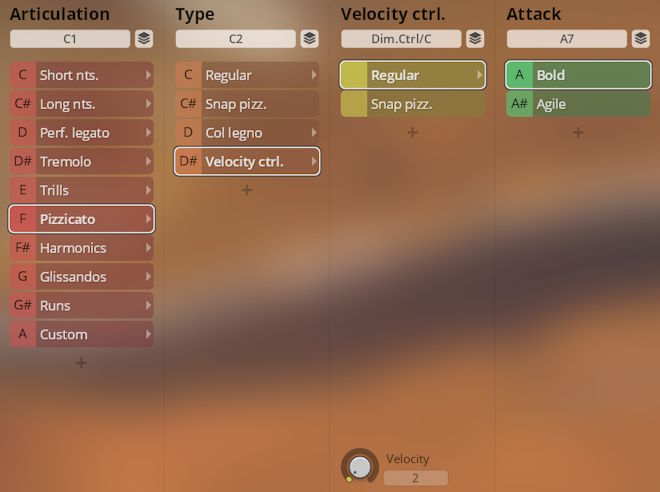
Harmonics
Harmonics sustained, tremolo with normal and fast attack; staccato bold and agile. With several crossfading combinations.
- Type
- C2–F2 (violins, violas)
- C6–F6 (cellos, basses)
- Normal/fast attack: A7/B7
- Staccato bold/agile: A7/A#7
In VelXF + Velocity Presets, attack is controlled by keystroke velocity instead of keyswitches.
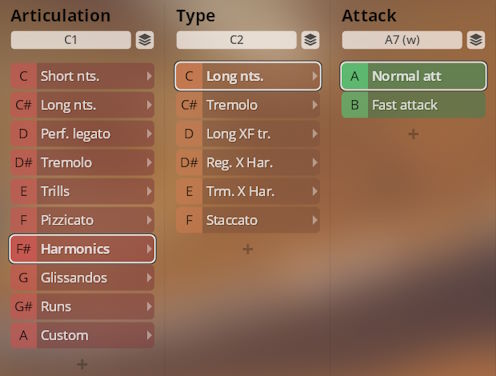
Long X tremolo / Regular X harmonics
Crossfading combinations between sustained and tremolo harmonics, and normal and harmonics sustains. Use Dim.Ctrl/A (CC20) to crossfade between articulations.
- Articulation XFade: Dim.Ctrl/A (CC20)
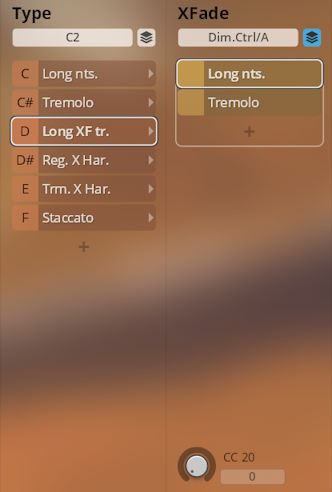
Tremolo X harmonics
Use Dim.Ctrl/A (CC20) to crossfade between normal and harmonics tremolo.
Tremolo normal/harmonics XFade: Dim.Ctrl/A (CC20).
- Normal/fast attack: A7/B7
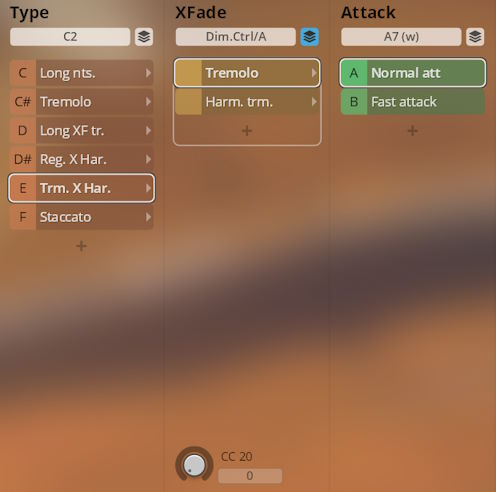
Staccato
Staccato harmonics, bold and agile.
- Bold/agile: A7/A#7
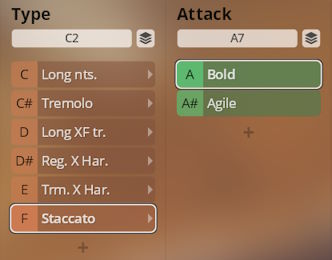
Glissandos
Glissandos normal and tremolo, fast and slow; octave, fifth, and major 2nd, up and down. With a normal/tremolo crossfading combination.
- Glissando type
- C2–D2 (violins, violas)
- C6–D6 (cellos, basses)
- Fast/slow: D#2/E2; D#6/E6
- Interval: F2–G2; G6–G6
- Up/down: A2/A#2; A6/A#6
In VelXF + Velocity Presets, up/down glissandos are controlled by keystroke velocity instead of keyswitches.
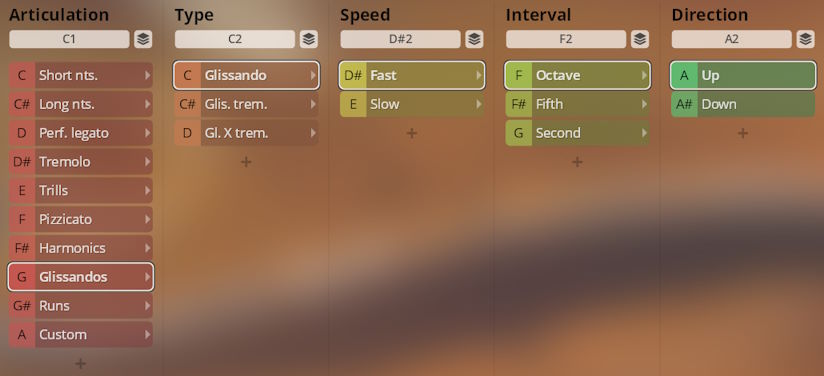
Normal X tremolo
Use Dim.Ctrl/A (CC20) to crossfade normal and tremolo glissandos.
- Normal/tremolo XFade: Dim.Ctrl/A (CC20)
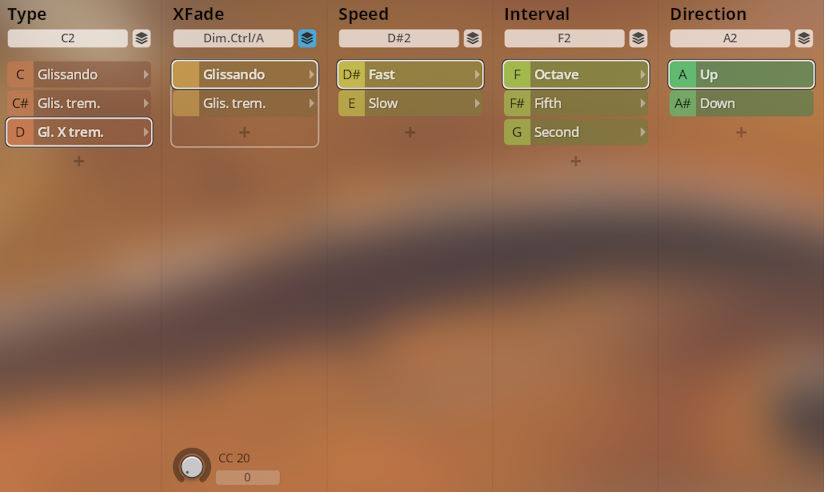
Runs
Legato and détaché runs, octave, fifth, and third (key and modal), up and down.
- Legato/détaché
- C2/C#2 (violins, violas)
- C6/C#6 (cellos, basses)
- Interval: F2–G#2, F6–G#6
- Key: C7–B7
- Up/down: A2/A#2; A6/A#6
In VelXF + Velocity Presets, up/down runs are controlled by keystroke velocity instead of keyswitches.
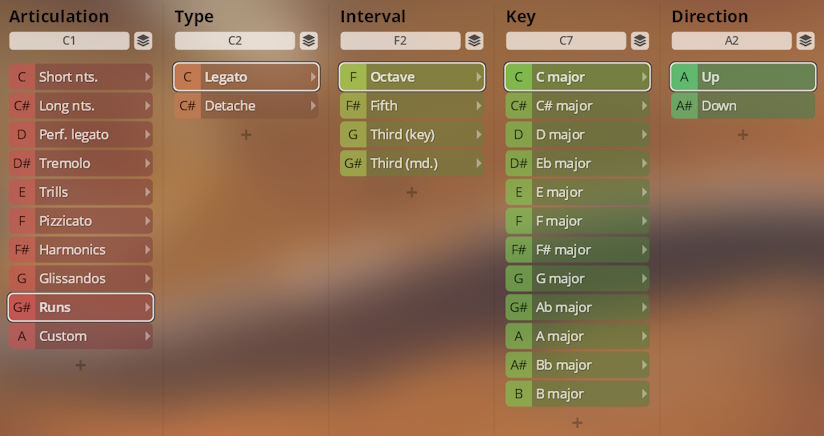
Third modal
Runs in thirds; major, minor, and phrygian scale.
- Mode: C7–D7

Custom
This “articulation” does not yet contain any patches. It provides 6 slots ready for you to configure presets of your own.
